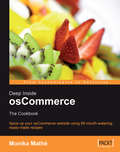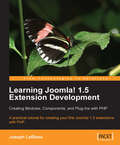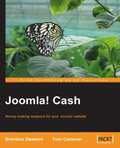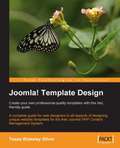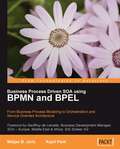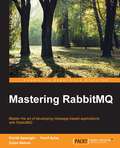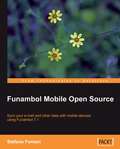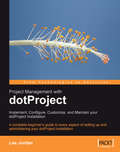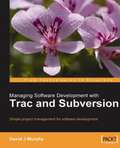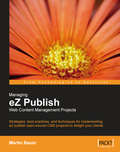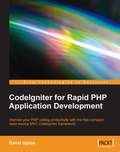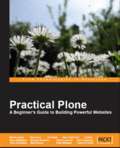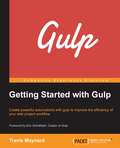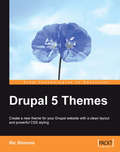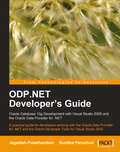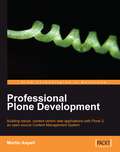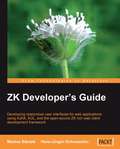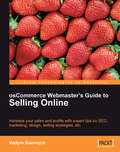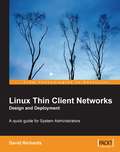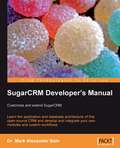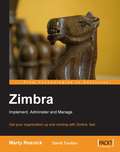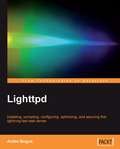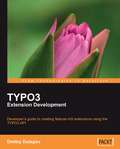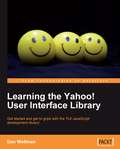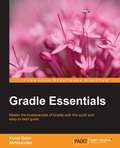- Table View
- List View
Deep Inside osCommerce: The Cookbook
by Monika MathéThis book is aimed at people with existing online stores, built using osCommerce. The book follows a systematic approach whereby users can modify and extend features on their already existing osCommerce site. Each chapter deals with a different aspect , and provides ready-made recipes for modifying code to your requirements. The author starts by explaining basic changes one can make to the design of your store, and then covers features like navigation, images, shipping and payment modules, and even explains how to make changes on the administratorâ TMs side and keeping your own recipes private. This book is for people who are already familiar with osCommerce. It presumes a working knowledge of PHP and HTML, as well as basic understanding of phpMyAdmin for database inserts.
Learning Joomla! 1.5 Extension Development: Creating Modules, Components, and Plugins with PHP
by Joseph L. LeblancA practical tutorial, based around the development of coherent example throughout the book. Each chapter walks you through the steps to add a required feature to the extension. This book is suitable for PHP programmers who want to take their first step in customizing and extending the features of Joomla! through custom PHP development. It is not a reference guide for advanced Joomla! developers. You need only the basics of PHP programming; no experience of developing Joomla! extensions is assumed. You are expected to be familiar with the general operation of Joomla!
Joomla! Cash
by Tom Canavan Brandon DawsonThis book is a fast and easy read, taking the reader from the inception of an idea, to a fully working cash-generating website built on Joomla! This book is suitable for business people with a medium level of technical skill who need a good primer on how to implement a cash-generating website. Those unfamiliar with Joomla! Would benefit from reading Building Websites with Joomla! 1.5 Beta 1.
Joomla! Template Design: Create your own professional-quality templates with this fast, friendly guide
by Tessa Blakeley SilverThis book is aimed at web designers who want to create their own unique templates for Joomla!. Readers should have basic knowledge of Joomla! (which can be obtained by working through Building Websites with Joomla!) and also some knowledge of CSS and HTML, and using Dreamweaver for coding purposes.
Business Process Driven SOA using BPMN and BPEL
by Matjaz B. Juric Kapil PantThe book provides a well-balanced mixture of theoretical discussion and real-world examples. It explains the concepts and approaches, and describes methodology and notation. It demonstrates these concepts on real-world examples and provides a step-by-step example tutorial that guides readers from business process modeling in BPMN through transformation into BPEL to execution on the SOA process server. It also discusses some key concepts using practical examples and business scenarios around Business Rules Management and Business Activity Monitoring with BPM and SOA. This book is for CIOs, executives, SOA project managers, business process analysts, BPM and SOA architects, who are responsible for improving the efficiency of business processes through IT, or for designing SOA. It provides a high-level coverage of business process modeling, but it also gives practical development examples on how to move from model to execution. We expect the readers to be familiar with the basics of SOA.
OSWorkflow A guide for Java developers and architects to integrating open-source Business Process Management
by Diego Adrian Naya LazoThis book gives step-by-step instructions on how to do things. The basics are explained first and then examples help to clarify and reinforce the principles. The book is aimed at experienced Java developers and system architects who want to develop complex Java applications using the OSWorkflow workflow engine. OSWorkflow is a flexible low-level workflow implementation for developers and architects; it is not a quick "plug-and-play" solution for non-technical end users.
Funambol Mobile Open Source
by Stefano FornariThe book is composed of two parts. The first part will take you through the steps required to fully understand and deploy Funambol to provide PIM synchronization and push email solution to your mobile users. This is done step-by-step, starting from a simple personal usage scenario to a more complex environment that must serve thousands of users. All components of the platform are smoothly introduced and explained, starting from the functionality they provide. The second part of the book is more informative and will assist you in building Funambol extensions. In particular, it contains an easy-to-follow tutorial that will allow you to write a Funambol connector in a few easy steps. If you are looking forward to install and get started with Funambol, this book is for you. You need to have a technical background and be confident with a bit of code tweaking, but not a developer. General server administration skills are assumed and familiarity with Java will be a benefit in places.
Project Management with dotProject: Implement, Configure, Customize, and Maintain your DotProject Installation
by Lee JordanThis book is a fast-paced, practical guide to getting things done with dotProject. It illustrates an easy and effective method to handle projects with the help of extensive real-world examples. The book is for a person or a group of people who are looking for an efficient and flexible project management tool for managing any kind of project. They may be users with technical knowledge such as system administrators or IT professionals, or users with basic computer and internet skills who want a project management tool that they can learn easily without having to learn HTML or a programming language. No prior experience of formal project management is required.
Managing Software Development with Trac and Subversion
by David J MurphyThis book combines theory with practical knowledge of how Trac and Subversion can help us to achieve the process of managing the software development. This book is aimed at developers of all calibres, but particularly those that lead teams or projects, especially if they have recently moved into the role or are simply looking for a better way.
Managing eZ Publish Web Content Management Projects
by Martin BauerThe book is not a technical implementation guide, but is packed with expert advice on all aspects of running an eZ publish web content management project. The author provides his unique insight and proven experience on crucial topics, pointing out common pitfalls and mistakes, and presenting strategies and practical tips with examples from real-world projects. This book is for people responsible for the implementation and management of eZ publish projects, and is ideal for people building sites for "medium to large clients". If you're a project manager running an eZ publish web content management project and you want to learn how to run your projects more efficiently, or you want a better understanding of all the elements involved in eZ publish web content management projects this book is for you. This is not an implementation guide or a book to learn eZ publish from - you will not be able to build a site by following this book. It is for people who have experienced eZ publish projects, or are considering them. Web developers new to eZ publish should read Learning eZ publish 3: Building Content Management Solutions first.
CodeIgniter for Rapid PHP Application Development
by David UptonThis book steps you through the main features of CodeIgniter in a systematic way, explaining them clearly with illustrative code examples. This book is for developers who are new to CodeIgniter. Basic skills in PHP and MySQL are required, but only rudimentary object-oriented knowledge is required. If you're looking for a better way to develop PHP applications, or want to find out more about the CodeIgniter framework as a viable option for one of your own projects, this book will help you.
Practical Plone 3: A Beginner's Guide to Building Powerful Websites
by Alex Clark Clayton ParkerThis is a beginner's practical guide that doesn't involve any code or programming concepts. You will learn by pointing and clicking on the options available in front of you. It includes easy-to-follow instructions and screenshots that will guide you through creating a powerful website. Each chapter stands alone and you need not go through all the chapters. You can pick and choose depending upon your requirements. If you want to get a Plone site up and running quickly and don't want to get involved in programming, this book is for you. This book is aimed at beginners, who want to configure and customize Plone to meet their content management needs. The book doesn't expect programming skills, although some knowledge of fundamental web concepts such as HTML and HTTP may be helpful.
ASP.NET Data Presentation Controls Essentials
by Joydip KanjilalThis book takes you through the most important tasks for working with the ASP.NET data presentation controls. Packed with example code and clear explanations, this book will make you a master of these controls in no time. This book is for ASP.NET developers who want to display or manage data in ASP.NET applications. The code examples are in C#.
Drupal 5 Themes
by Ric ShrevesThis book is the ideal introduction to theming with Drupal 5. If you want to create a striking new look for your Drupal website, this book is for you. Starting from the basics of theme setup and configuration, you will learn about the Drupal theming architecture and the PHPTemplate engine, and then move on to modifying existing themes and building new themes from scratch. Included is a complete guide to the various style sheets and themeable functions in Drupal 5, making this book a valuable resource even to experienced theme developers. It covers: Creating custom templates Basics of theming in pure PHP Modifying an existing PHPTemplate theme" a step-by-step guide Creating a new PHPTemplate theme" a step-by-step guide Working with forms The main requirements to make use of this book are knowledge of HTML, CSS, and a touch of creativity! Although this book aims to make Drupal theming accessible to designers, theming in Drupal 5 involves writing some PHP code, and a basic knowledge of PHP will be helpful.
ODP.NET Developer’s Guide: Oracle Database 10g Development with Visual Studio 2005 and the Oracle Data Provider for .NET
by Jagadish Chatarji Pulakhandam Sunitha ParuchuriThis book uses many hands-on examples to show you how to use ODP.NET and Oracle Developer Tools from within Visual Studio 2005 to access Oracle Database 10g. The book is written for professional .NET developers who need to work with and take full advantage of Oracle Database 10g using Visual Studio 2005. Developers are expected to be familiar with Visual Basic.NET 2005 and have minimum knowledge of Oracle SQL and PL/SQL.
Professional Plone Development
by Martin AspeliThis book is designed for readers who learn by doing and employs many examples and screenshots to let the reader dig in and start coding. This book isn't designed to be a reference; instead it has a practical, example-driven approach that teaches you by following along with the examples in the chapters. When you have completed this book, you will fully understand how the template system works, how to extend it when you have specialized needs, and how to optimize the performance and usability of your content. This book is for web developers and template authors who want to fully understand and utilize the Django template system. The reader should have completed the introductory tutorials on the Django project's website and some experience with the framework will be very helpful. Basic knowledge of Python and HTML is assumed.
ZK Developer's Guide
by Markus Stäuble Jurgen SchumacherZK is an open-source web development framework that enables web applications to have the rich user experiences and low development costs that desktop applications have had for years. ZK includes an Ajax-based event-driven engine, rich sets of XML User Interface Language (XUL) and XHTML components, and a markup language. The ZK rich client framework takes the so-called server-centric approach: the content synchronization of components and the event pipelining between clients and servers are automatically done by the engine and Ajax plumbing codes are completely transparent to web application developers. Therefore, the end users get rich user interfaces with similar engaged interactivity and responsiveness to that of desktop applications, while for programmers, development remains similar in simplicity to that of desktop applications. This book is a Developer's Guide that steps you through the ZK framework with examples. It starts with installing and configuring ZK and takes you on to integrate it with other frameworks. By the time you are through the book you will be able to build an application on your own.
osCommerce Webmaster's Guide to Selling Online
by Vadym GurevychPacked with expert advice and practical examples of effective store design and report creation to help you make better decisions, formulate more effective strategies, and measure your success. This book is for anyone administering an osCommerce site, including webmasters, content managers, store owners, and marketing managers, who do not need to understand PHP or MySQL to benefit from this book. The tips and techniques described in this book can be applied to any small, medium sized e-commerce site. This is not an implementation guide; developers implementing osCommerce-based e-commerce sites would benefit from reading Deep Inside osCommerce: The Cookbook.
Linux Thin Client Networks Design and Deployment
by David RichardsThe book consists of HOW-TOs for all elements of setting up a thin client network, as well as expert advice on decision making, based on the authors experience creating a thin client network for the city of Largo, Florida. The book is for System Administrators interested in designing and setting up a Linux thin client network and provides enough knowledge to understand how the technology works, make decisions about deployment, and then implement a stable work environment.
SugarCRM Developer's Manual: Customize and extend SugarCRM
by Dr Mark Alexander BainThe book is structured as: An overview of the architecture of the application and database, how it all fits together A module development tutorial, showing the essential steps for hooking your module into the SugarCRM infrastructure A section of common customizations that can be performed against the codebase The book is for PHP developers working with SugarCRM, who want to extend its capabilities. Readers should have a basic knowledge of SugarCRM as the book does not cover installation and usage of SugarCRM. This can be gained from Implementing SugarCRM.
Zimbra Implement, Administer and Manage
by Marty Resnick David TouitouThis is a compact Administrators Guide. It is friendly, and contains plenty of step-by-step instructions for installation and configuration of Zimbra as well as useful references and checklists. Administrators working with Zimbra on Linux or Mac OS X. Administrators who want to set up Zimbra for use in small/medium businesses.
Lighttpd
by Andre BogusThis book is for System Administrators or Web Developers seeking a lean deployment platform for web applications or who want to switch to a "lighter" web server than Apache.
TYPO3 Extension Development
by Dmitry DulepovThe book is structured so that following the chapters in order builds a TYPO3 extension from the ground up. Experienced developers can use individual chapters independently to get only the information that they need. Each chapter is divided so that the first part contains a description and discussion of the topic covered followed by a coding example with explanation of how principles and techniques from the first part are followed in the code. The reader is encouraged not only to read the book but also to look into the discussed classes and actually code the extension while reading the book. This book is for PHP developers who want to develop a TYPO3 extension. It assumes the reader has experience with PHP, XML, and HTML. No prior knowledge about TYPO3 extension programming or the TYPO3 API is presumed.
Learning the Yahoo! User Interface library
by Dan WellmanThe book is a tutorial, leading the reader first through the basics of the YUI library before moving on to more complex examples involving the YUI controls and utilities. The book is heavily example driven, and based around an approach of tinkering and extending to improve. This book is for web developers comfortable with JavaScript and CSS, who want to use the YUI library to easily put together rich, responsive web interfaces. No knowledge of the YUI library is presumed.
Business Process Management with JBoss jBPM
by Matt CumberlidgeThis book takes a practical approach, with step-by-step instructions for business process management, model creation, and implementation. The book uses a typical BPM project lifecycle case study to explore and explain the process in a realistic situation. This is a book for Business Analysts (BAs) who need to develop a process model for implementation in a business process management system. Developers looking at the JBoss jBPM toolset will also find it a useful introduction to the key concepts. This book is a full toolkit for someone who wants to implement BPM in the right way. This toolkit is particularly aimed at Business Analysts, although Project Managers, IT managers, developers, and even business people can expect to find useful tools and techniques in here. We will present the project framework, analysis techniques and templates, BPM technology and example deliverables that you need to successfully bring a BPM solution into your organization.
